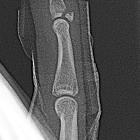Ausriss der volaren Platte am Finger

















Volar plate avulsion injuries are a type of avulsion injury. The volar plate of the proximal interphalangeal (PIP) joint is vulnerable to hyperextension injury, in the form of either a ligament tear or an intra-articular fracture.
Gross anatomy
The volar plate forms the floor of the PIP joint separating the joint space from the flexor tendon sheath. The volar plate has a ligamentous origin on the proximal phalanx with a capsular insertion onto the middle phalanx.
Pathology
Hyperextension injury involving the PIP of the finger can avulse the volar plate which is commonly associated with a volar avulsion fracture at the base of the middle phalanx.
When the volar avulsion fracture involves a significant portion of the articular surface, instability and dorsal dislocation of middle phalanx can occur. This is because a greater portion of the stabilizing collateral ligaments is attached to the avulsed fragment.
Classification
Knowledge of the orthopedic Eaton classification is practical when reporting volar plate injury as it influences the decision on management . Treatment is dependent on the following factors:
- size of the fragment (<40% of articular segment)
- degree of impaction
- direction of the dislocation
Another classification which is considered useful for management is the Keifhaber-Stern classification.
Radiographic features
A small fragment of bone is avulsed from the volar base of the middle phalanx. If there is significant involvement of the articular surface, this may be associated with dorsal dislocation of the middle phalanx.
Treatment and prognosis
Overall, a small fragment involving <40% of the articular segment and/or reducible fracture with < 30 degrees of flexion is usually managed conservatively with finger splinting. A large fragment or > 30 degrees of flexion to reduce the fragment and malalignment post-closed reduction are indicators for operative treatment.
Siehe auch:

 Assoziationen und Differentialdiagnosen zu Ausriss der volaren Platte am Finger:
Assoziationen und Differentialdiagnosen zu Ausriss der volaren Platte am Finger:


